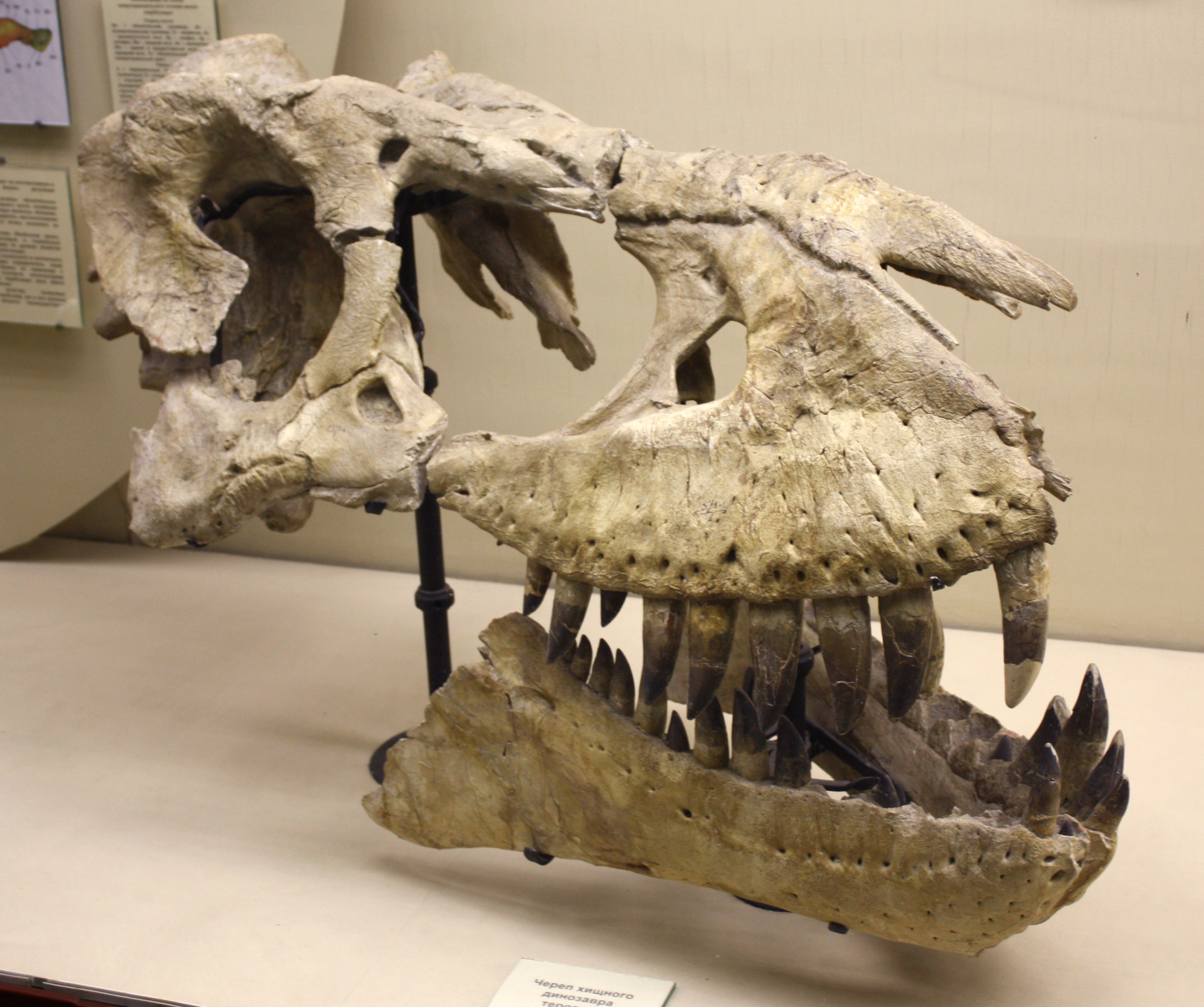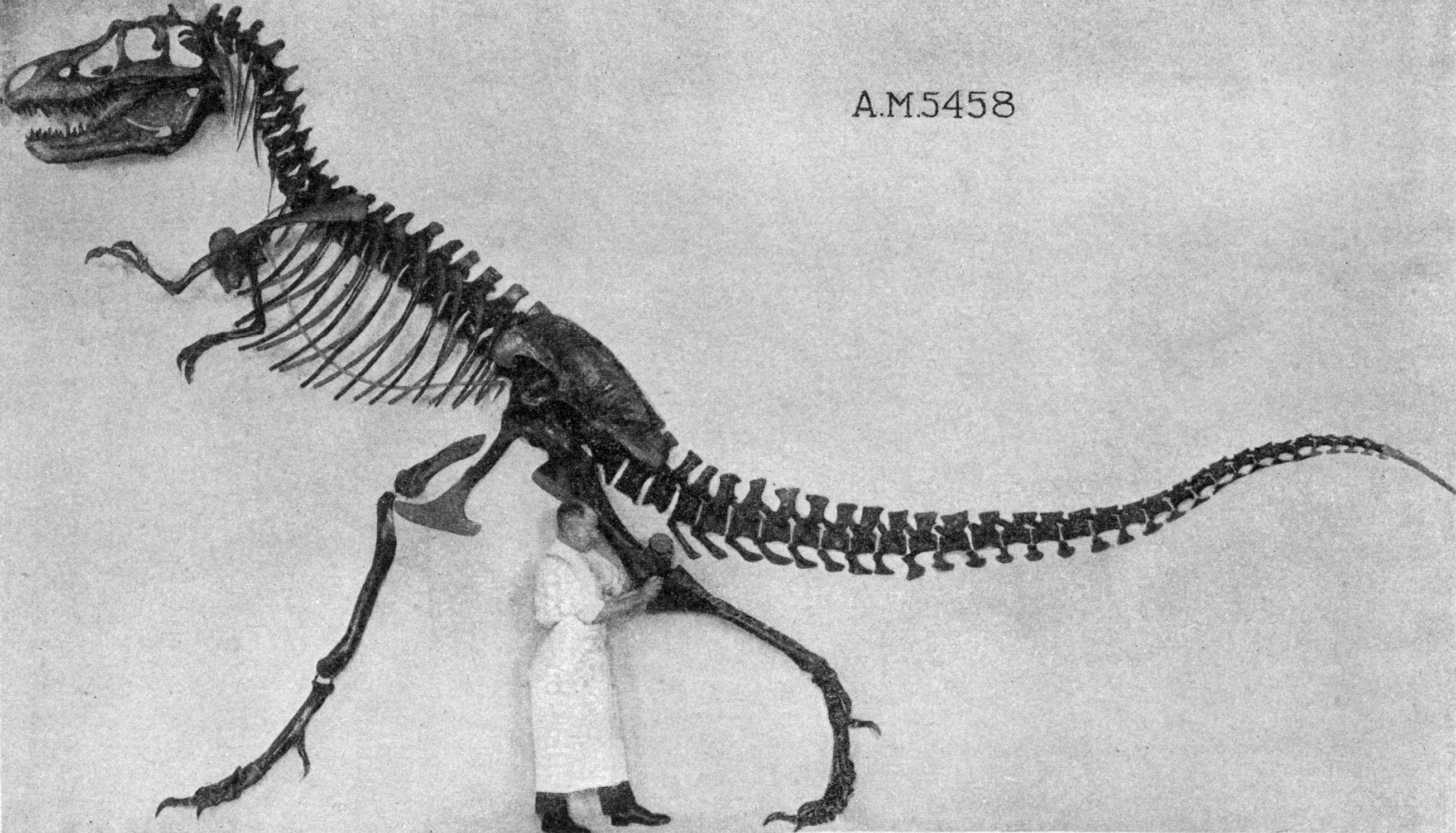|
Tyrannosaurids
Tyrannosauridae (or tyrannosaurids, meaning "tyrant lizards") is a family of coelurosaurian theropod dinosaurs that comprises two subfamilies containing up to fifteen genera, including the eponymous ''Tyrannosaurus''. The exact number of genera is controversial, with some experts recognizing as few as three. All of these animals lived near the end of the Cretaceous Period and their fossils have been found only in North America and Asia. Although descended from smaller ancestors, tyrannosaurids were almost always the largest predators in their respective ecosystems, putting them at the apex of the food chain. The largest species was ''Tyrannosaurus rex'', the most massive known terrestrial predator, which measured over in length and according to most modern estimates up to in weight. Tyrannosaurids were bipedal carnivores with massive skulls filled with large teeth. Despite their large size, their legs were long and proportioned for fast movement. In contrast, their arms were v ... [...More Info...] [...Related Items...] OR: [Wikipedia] [Google] [Baidu] |
Tyrannosaurus
''Tyrannosaurus'' () is a genus of large theropod dinosaur. The type species ''Tyrannosaurus rex'' ( meaning 'king' in Latin), often shortened to ''T. rex'' or colloquially t-rex, is one of the best represented theropods. It lived throughout what is now western North America, on what was then an island continent known as Laramidia. ''Tyrannosaurus'' had a much wider range than other tyrannosaurids. Fossils are found in a variety of geological formations dating to the latest Campanian-Maastrichtian ages of the late Cretaceous period, 72.7 to 66 million years ago, with isolated specimens possibly indicating an earlier origin in the middle Campanian. It was the last known member of the tyrannosaurids and among the last non- avian dinosaurs to exist before the Cretaceous–Paleogene extinction event. Like other tyrannosaurids, ''Tyrannosaurus'' was a bipedal carnivore with a massive skull balanced by a long, heavy tail. Relative to its large and powerful hind limbs, ... [...More Info...] [...Related Items...] OR: [Wikipedia] [Google] [Baidu] |
Tyrannosauroidea
Tyrannosauroidea (meaning 'tyrant lizard forms') is a superfamily (or clade) of coelurosaurian theropod dinosaurs that includes the family Tyrannosauridae as well as more basal relatives. Tyrannosauroids lived on the Laurasian supercontinent beginning in the Jurassic Period. By the end of the Cretaceous Period, tyrannosauroids were the dominant large predators in the Northern Hemisphere, culminating in the gigantic ''Tyrannosaurus''. Fossils of tyrannosauroids have been recovered on what are now the continents of North America, Europe and Asia. If Megaraptora is part of Tyrannosauroidea, this would extend the distribution of the group to Australia and South America, and possible fragmentary remains of tyrannosauroids have also been reported from these continents. Tyrannosauroids were bipedal carnivores, as were most theropods, and were characterized by numerous skeletal features, especially of the skull and pelvis. Early in their existence, tyrannosauroids were small predat ... [...More Info...] [...Related Items...] OR: [Wikipedia] [Google] [Baidu] |
Tarbosaurus
''Tarbosaurus'' ( ; meaning "alarming lizard") is a genus of large tyrannosaurid dinosaur that lived in Asia during the Late Cretaceous epoch, about 70 million years ago (Maastrichtian age). It contains the single type species: ''Tarbosaurus bataar'', which is known from the Nemegt Formation of Mongolia, with more fragmentary remains found further afield in the Subashi Formation of China. ''Tarbosaurus'' is represented by dozens of fossil specimens, including several complete skulls and skeletons. These remains have allowed studies focusing on its phylogeny, skull mechanics, and brain structure. Further fossil remains have been reported from other geologic formations of Asia, however, these remains are fragmentary and cannot be confidently assigned to ''Tarbosaurus'' or the type species. Like most known tyrannosaurids, ''Tarbosaurus'' was a large bipedal predator, with the type specimen measuring approximately long, tall at the hips, and weighing up to . It had a unique lo ... [...More Info...] [...Related Items...] OR: [Wikipedia] [Google] [Baidu] |
Gorgosaurus
''Gorgosaurus'' ( ; ) is a genus of tyrannosaurid theropod dinosaur that lived in western North America during the Late Cretaceous Period (Campanian), between about 76.5 and 75 million years ago. Fossil remains have been found in the Canadian province of Alberta and the U.S. state of Montana. Paleontologists recognize only the type species, ''G. libratus'', although other species have been erroneously referred to the genus. Like most known tyrannosaurids, ''Gorgosaurus'' was a large bipedal predator, measuring in length and in body mass. Dozens of large, sharp teeth lined its jaws, while its two-fingered forelimbs were comparatively small. ''Gorgosaurus'' was most closely related to ''Albertosaurus'', and more distantly related to the larger ''Tyrannosaurus''. ''Gorgosaurus'' and ''Albertosaurus'' are extremely similar, distinguished mainly by subtle differences in the teeth and skull bones. Some experts consider ''G. libratus'' to be a species of ''Albertosaurus''; th ... [...More Info...] [...Related Items...] OR: [Wikipedia] [Google] [Baidu] |
Tyrannosaurinae
Tyrannosaurinae (or tyrannosaurines) is one of the two extinct subfamilies of Tyrannosauridae, a family of coelurosaurian theropods that consists of at least three tribes and several genera. All fossils of these genera have been found in the Late Cretaceous deposits of western North America and east Asia. Compared to the related subfamily Albertosaurinae, tyrannosaurines overall are more robust and larger though the alioramins were gracile by comparison. This subfamily also includes '' Lythronax'', one of the oldest known tyrannosaurid genera, as well as the youngest and most famous member of the group, ''Tyrannosaurus rex''. History of discovery The first remains of tyrannosaurids were uncovered during expeditions led by the Geological Survey of Canada, which located numerous scattered teeth. These distinctive dinosaur teeth were given the name '' Deinodon'' ("terrible tooth") by Joseph Leidy in 1856. In 1892 Edward Drinker Cope described more tyrannosaur material in the f ... [...More Info...] [...Related Items...] OR: [Wikipedia] [Google] [Baidu] |
Albertosaurinae
Albertosaurines, or dinosaurs of the subfamily Albertosaurinae, lived in the Late Cretaceous of United States and Canada. The subfamily was first used by Philip J. Currie, Jørn H. Hurum, and Karol Sabath as a group of tyrannosaurid dinosaurs. It was originally defined as "(''Albertosaurus'' + ''Gorgosaurus'')", including only the two genera. The group is the sister clade to Tyrannosaurinae. In 2007, it was found that the group also contained '' Maleevosaurus'', often synonymized with ''Tarbosaurus''. However, this classification has not been accepted and '' Maleevosaurus'' is still considered a juvenile ''Tarbosaurus'' or ''Tyrannosaurus''. Description Albertosaurines are large, lightly built tyrannosaurids. Compared to tyrannosaurines, they are more slender and have shorter, flatter skulls, shorter ilia, and proportionally longer tibiae. Albertosaurines and tyrannosaurines share arms of about equal length, with the exception of ''Tarbosaurus'', which had short arms for ... [...More Info...] [...Related Items...] OR: [Wikipedia] [Google] [Baidu] |
Late Cretaceous
The Late Cretaceous (100.5–66 Ma) is the more recent of two epochs into which the Cretaceous Period is divided in the geologic time scale. Rock strata from this epoch form the Upper Cretaceous Series. The Cretaceous is named after ''creta'', the Latin word for the white limestone known as chalk. The chalk of northern France and the white cliffs of south-eastern England date from the Cretaceous Period. Climate During the Late Cretaceous, the climate was warmer than present, although throughout the period a cooling trend is evident. The tropics became restricted to equatorial regions and northern latitudes experienced markedly more seasonal climatic conditions. Geography Due to plate tectonics, the Americas were gradually moving westward, causing the Atlantic Ocean to expand. The Western Interior Seaway divided North America into eastern and western halves; Appalachia and Laramidia. India maintained a northward course towards Asia. In the Southern Hemisphere, Aus ... [...More Info...] [...Related Items...] OR: [Wikipedia] [Google] [Baidu] |
Genus
Genus (; : genera ) is a taxonomic rank above species and below family (taxonomy), family as used in the biological classification of extant taxon, living and fossil organisms as well as Virus classification#ICTV classification, viruses. In binomial nomenclature, the genus name forms the first part of the binomial species name for each species within the genus. :E.g. ''Panthera leo'' (lion) and ''Panthera onca'' (jaguar) are two species within the genus ''Panthera''. ''Panthera'' is a genus within the family Felidae. The composition of a genus is determined by taxonomy (biology), taxonomists. The standards for genus classification are not strictly codified, so different authorities often produce different classifications for genera. There are some general practices used, however, including the idea that a newly defined genus should fulfill these three criteria to be descriptively useful: # monophyly – all descendants of an ancestral taxon are grouped together (i.e. Phylogeneti ... [...More Info...] [...Related Items...] OR: [Wikipedia] [Google] [Baidu] |
Theropoda
Theropoda (; from ancient Greek [wiktionary:θηρίον, , (''therion'') "wild beast"; wiktionary:πούς, , wiktionary:ποδός, (''pous, podos'') "foot"]) is one of the three major groups (Clade, clades) of Dinosaur, dinosaurs, alongside Ornithischia and Sauropodomorpha. Theropods, both extant and extinct, are characterized by hollow bones and three toes and claws on each limb. They are generally classed as a group of saurischian dinosaurs, placing them closer to sauropodomorphs than to ornithischians. They were ancestrally carnivorous, although a number of theropod groups evolved to become herbivores and omnivores. Members of the subgroup Coelurosauria and possibly some other or all theropods were covered in Feather, feathers. In the Jurassic, birds evolved from small specialized coelurosaurian theropods, and are currently represented by about 11,000 living species, making theropods the only group of dinosaurs alive today. Theropods first appeared during the Ca ... [...More Info...] [...Related Items...] OR: [Wikipedia] [Google] [Baidu] |
Dinosaur
Dinosaurs are a diverse group of reptiles of the clade Dinosauria. They first appeared during the Triassic Geological period, period, between 243 and 233.23 million years ago (mya), although the exact origin and timing of the #Evolutionary history, evolution of dinosaurs is a subject of active research. They became the dominant terrestrial vertebrates after the Triassic–Jurassic extinction event 201.3 mya and their dominance continued throughout the Jurassic and Cretaceous periods. The fossil record shows that birds are feathered dinosaurs, Evolution of birds, having evolved from earlier Theropoda, theropods during the Late Jurassic epoch, and are the only dinosaur lineage known to have survived the Cretaceous–Paleogene extinction event approximately 66 mya. Dinosaurs can therefore be divided into avian dinosaurs—birds—and the extinct non-avian dinosaurs, which are all dinosaurs other than birds. Dinosaurs are varied from taxonomy (biology), taxonomic, ... [...More Info...] [...Related Items...] OR: [Wikipedia] [Google] [Baidu] |
Period (geology)
The geologic time scale or geological time scale (GTS) is a representation of time based on the rock record of Earth. It is a system of chronological dating that uses chronostratigraphy (the process of relating strata to time) and geochronology (a scientific branch of geology that aims to determine the age of rocks). It is used primarily by Earth scientists (including geologists, paleontologists, geophysicists, geochemists, and paleoclimatologists) to describe the timing and relationships of events in geologic history. The time scale has been developed through the study of rock layers and the observation of their relationships and identifying features such as lithologies, paleomagnetic properties, and fossils. The definition of standardised international units of geological time is the responsibility of the International Commission on Stratigraphy (ICS), a constituent body of the International Union of Geological Sciences (IUGS), whose primary objective is to precisely ... [...More Info...] [...Related Items...] OR: [Wikipedia] [Google] [Baidu] |
Eponym
An eponym is a noun after which or for which someone or something is, or is believed to be, named. Adjectives derived from the word ''eponym'' include ''eponymous'' and ''eponymic''. Eponyms are commonly used for time periods, places, innovations, biological nomenclature, astronomical objects, works of art and media, and tribal names. Various orthographic conventions are used for eponyms. Usage of the word The term ''eponym'' functions in multiple related ways, all based on an explicit relationship between two named things. ''Eponym'' may refer to a person or, less commonly, a place or thing for which someone or something is, or is believed to be, named. ''Eponym'' may also refer to someone or something named after, or believed to be named after, a person or, less commonly, a place or thing. A person, place, or thing named after a particular person share an eponymous relationship. In this way, Elizabeth I of England is the eponym of the Elizabethan era, but the Elizabethan ... [...More Info...] [...Related Items...] OR: [Wikipedia] [Google] [Baidu] |










